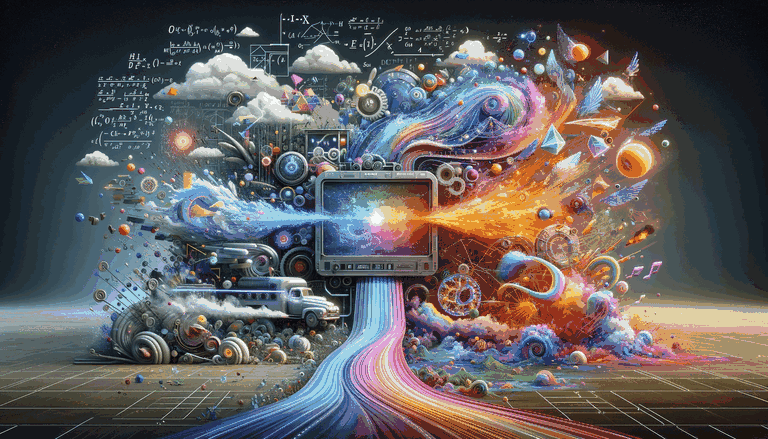How AI Video Generators Transform Concepts into Visual Masterpieces

In the era of rapid technological advancements, artificial intelligence (AI) has permeated various facets of our lives, bringing forth innovative solutions that were once deemed impossible. One such marvel is the AI video generator, a groundbreaking tool that has revolutionized the way we create and consume visual content. In this article, we will delve into the intricacies of how AI video generators work, unraveling the magic behind their ability to transform concepts into captivating videos.
Understanding the Basics
At its core, an AI video generator relies on deep learning algorithms, specifically convolutional neural networks (CNNs) and recurrent neural networks (RNNs), to analyze and synthesize visual content. These networks are trained on vast datasets that include a diverse range of videos, enabling the AI to learn patterns, styles, and correlations within the data.
The Process
Data Collection and Preprocessing
The first step involves gathering a massive amount of diverse video data. This data is then preprocessed to extract relevant features, such as frames, objects, and motion patterns. This step is crucial for training the AI to recognize and replicate various visual elements.
Training the Neural Networks
Convolutional neural networks (CNNs) are employed for image analysis, allowing the AI to understand the visual components within each frame. Recurrent neural networks (RNNs) come into play for temporal analysis, enabling the system to grasp the sequential nature of video content.
Feature Extraction and Representation
During training, the AI learns to extract meaningful features from the input data. These features serve as the building blocks for generating new content. The AI becomes adept at understanding the relationships between objects, scenes, and movements within videos.
Conceptualization and Scene Understanding
The AI video generator goes beyond mere replication by understanding the conceptual aspects of the content. It learns to recognize scenes, interpret context, and comprehend the narrative structure of videos.
Content Synthesis
Armed with the knowledge acquired during training, the AI can now synthesize new video content. Given a textual or visual input, the generator employs its learned features to construct coherent and visually appealing sequences.
Style Transfer and Enhancement
To add a touch of creativity, some AI video generators incorporate style transfer techniques. These techniques allow the generator to emulate the artistic styles of famous painters or specific visual genres, infusing the generated videos with unique aesthetics.
Output Refinement
The final step involves refining the generated output to ensure smooth transitions, realistic movements, and overall visual coherence. This may involve additional post-processing techniques to enhance the quality of the final video.
Use Cases for AI Video Generators in 2025
In 2025, AI video generators have evolved from niche tools to must-haves for marketing departments, content creators, educators, and product teams alike. Their growing accessibility—including platforms offering AI video generator free options—has driven mainstream adoption across sectors.
Marketing and Personalization at Scale
Marketing teams are leveraging AI video generators to produce highly personalized content. With just a few lines of text, they can create image to video campaigns that are tailored by region, language, or even audience behavior. An AI avatar can deliver a product message in multiple languages, enabling instant localization at scale. For global brands, this approach saves weeks of production time and significantly boosts campaign relevance and reach.
Education and Remote Training
Educators and corporate trainers are using AI-powered video tools to create engaging tutorials and training modules faster than ever. An instructor can turn a PowerPoint slide or still image into a full explainer video using ai animation and voice generation. In corporate settings, onboarding videos that once took weeks to produce can now be generated in hours using templated, yet personalized, video flows.
Content Creation and Influencer Growth
Content creators, from YouTubers to Instagram influencers, are tapping into AI tools to maintain high-frequency publishing schedules. Short-form videos can be created automatically from scripts or summaries, reducing burnout while increasing consistency. Creators are also experimenting with AI avatars that act as digital co-hosts or voice their content in different styles or personas—helping them stand out in crowded feeds.
Customer Support and Product Walkthroughs
Support teams are using AI video generators to automate FAQ responses and visual walkthroughs. Instead of sending a long help article, a business can send a video with a friendly AI avatar walking through the solution step by step. This not only improves user experience but also reduces ticket volumes by delivering clearer, more digestible guidance.
Internal Communications and Company Updates
In large organizations, AI video tools are helping leadership teams share announcements in a more engaging way. A static memo can become a dynamic, branded video featuring an AI avatar of the CEO or spokesperson delivering the message. With voice and animation handled by AI, these videos maintain a human tone without requiring scheduling, filming, or editing resources.
As these use cases expand, so does the value of these platforms. With free and paid options available, teams of all sizes can now use AI to streamline video production and unlock new creative formats—without the traditional bottlenecks of scripting, filming, or post-production.
Challenges and Future Developments
While AI video generators have achieved remarkable success, challenges remain, such as handling complex scenes, ensuring ethical use, and improving real-time generation capabilities. The future holds exciting prospects, including advancements in generative adversarial networks (GANs), increased computational power, and the integration of AI video generators into various industries.
AI video generators represent a paradigm shift in content creation, offering a glimpse into a future where machines, including AI agents, can effortlessly translate ideas into captivating visual experiences. As we continue to push the boundaries of AI technology, the possibilities for creative expression and storytelling are boundless, ushering in an era where the line between human and machine-generated content, facilitated by AI avatars, becomes increasingly blurred.
FAQs
-
Yes, many platforms offer free tiers or trials. These options are a great way to experiment before investing in premium features.
-
AI animation uses algorithms to generate motion from static inputs, like text or images. It automates the creation of animated scenes without needing manual keyframes or modeling.
-
AI avatars are designed to look and behave like real humans, often for communication or training purposes. Animated characters are typically cartoon-style and used in storytelling or entertainment.
-
Absolutely. Many tools now offer image to video conversion by animating still photos or generating motion graphics based on visual cues. Try it out on D-ID’s Studio.
Was this post useful?
Thank you for your feedback!
 Libi Michelson
Libi Michelson